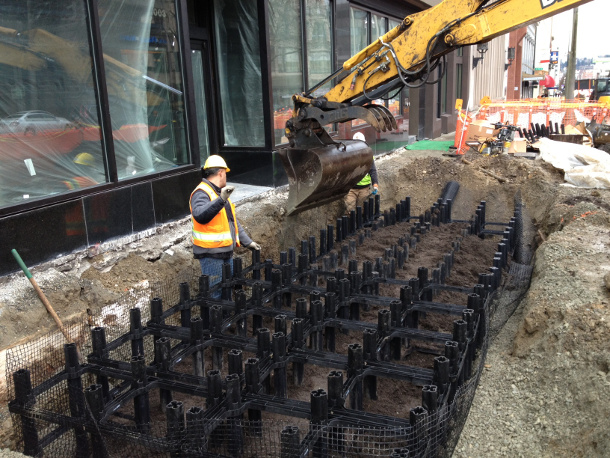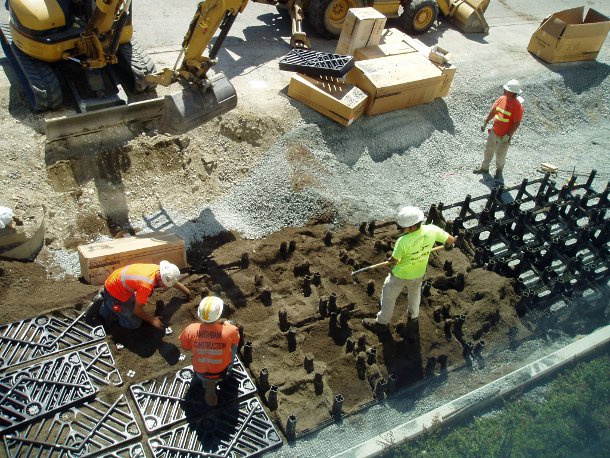For the last two weeks in December I’m be re-posting some of my favorite blog posts from this year. Today’s shares some of the most exciting news we got in 2013, when the Washington State Department of Ecology recognized the Silva Cell as being functionally equivalent to a rain garden. Scroll all the way to the bottom to see our official letter! To date we have had 11 Silva Cell installations in Washington state. – LM
The Silva Cell has officially been designated as an approved equal for bioretention facilities by the Washington State Department of Ecology. Designers and engineers who want to incorporate Silva Cells in to their projects can now refer to the official document, Using the Western Washington Hydrology Model (Version 4.0) to Size Silva Cells for Runoff Treatment and Flow Control.These guidelines present hydrologic modeling procedures for sizing Silva Cell Best Management Practices (BMPs) to meet Washington State Department of Ecology minimum stormwater requirements outlined in the 2012 Ecology Stormwater Management Manual for Western Washington using the Western Washington Hydrology Model, Version 4.0 (WWHM4).

The guidelines are intended to supplement the Using the Western Washington Hydrology Model to Size Silva Cells for Stormwater Filtration, dated November 24, 2009. The 2009 guidelines provide instructions for sizing Silva Cells to meet treatment requirements only, using a sand filter to represent the Silva Cell BMP. The new guidelines present a method for modeling Silva Cells to meet treatment and flow control requirements, allowing the designer to eliminate or reduce the need for other stormwater BMPs on-site.
 In 2010, Silva Cells were installed under a sidewalk rain garden along Aurora Avenue in Shoreline, WA and topped with pavers. Photo: Curtis LaPierre/Otak
In 2010, Silva Cells were installed under a sidewalk rain garden along Aurora Avenue in Shoreline, WA and topped with pavers. Photo: Curtis LaPierre/Otak
 Silva Cells were installed under a sidewalk rain garden along Aurora Avenue in Shoreline, WA and topped with pavers. This is the site in 2012.
Silva Cells were installed under a sidewalk rain garden along Aurora Avenue in Shoreline, WA and topped with pavers. This is the site in 2012.
This document provides step-by-step instructions for modeling Silva Cells using the bioretention Element in WWHM4. The benefit of using the bioretention element instead of the sand filter element is that both flow control and treatment performance can be evaluated. Silva Cells provide treatment by filtering stormwater runoff through a soil media that meets Ecology’s filter medium criteria. Similar to bioretention, Silva Cells also provide flow control by promoting infiltration to native soils in areas that are suitable for infiltration. Because Silva Cells support the growth of large, healthy trees, they also offer additional flow control benefits through canopy interception, evapotranspiration, and enhanced infiltration as the roots grow and develop macropores in the soil. For purposes of sizing Silva Cells to meet Minimum Requirement #7 (Flow Control), only storage and infiltration into native soils are modeled. The additional flow control benefits provided by tree canopy interception, evapotranspiration, and enhanced infiltration are not included in the model.

The new guidelines walk through the modeling procedures step-by-step and include two project examples. Silva Cells have already been used on many tree-and-stormwater projects in the Seattle area, including outside the Escala building (Seattle), along Pacific Avenue (Tacoma), Aurora Avenue (Shoreline), Winslow Way (Bainbridge Island), Park Lane (Kirkland), and a Park & Ride (Mountlake Terrace).
To get started using these modeling guidelines, visit the Washington State Department of Ecology Equivalent Technologies website. If you have a project where you’d like to use Silva Cells for bioretention, please contact us for technical support and assistance.






Leave Your Comment